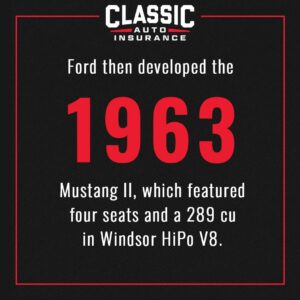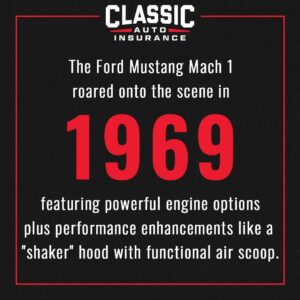Get a Quote
Home » Insurance for Classic & Collector Cars » Muscle Car Insurance » Mustang Insurance
Mustang Insurance
 The Ford Mustang is a remarkable vehicle both inside and out, so it’s no mystery why it’s a dream car for countless motorheads. If you’re the proud owner of this legendary car, you need premium Ford Mustang insurance coverage options designed for your unique ride.
The Ford Mustang is a remarkable vehicle both inside and out, so it’s no mystery why it’s a dream car for countless motorheads. If you’re the proud owner of this legendary car, you need premium Ford Mustang insurance coverage options designed for your unique ride.
Classic Auto offers tailored policies and personalized rates for Ford Mustangs. Our car insurance rates are based on the agreed-upon value, which means our insurance professionals will work with you to determine the true worth of your Ford Mustang. Classic Auto’s Ford Mustang insurance policies also come with great driver discounts, flexible mileage plans, rollover miles, inflation guard, and other coverage benefits that can help you save money, compared to the national average, and save your investment.
If you have pricing questions or would like to learn more about our Ford Mustang insurance policies, call 888-901-1338. Our experienced car insurance team can answer your questions and explain our full coverage options for Ford insurance, as well as any discounts available. You can also get an instant quote for insurance rates here.
How the Mustang Got Its Start
 Lee Iacocca, general manager of Ford, developed the Mustang I concept car in 1962. He aimed to develop a sporty and powerful ride that would attract younger customers compared to the average Ford driver. After 18 months of development, Ford completed the first Mustang concept car, deriving the name from the World War II P-51 Mustang fighter plane. Ford then developed the 1963 Mustang II, which featured four seats and a 289 cu in Windsor HiPo V8.
Lee Iacocca, general manager of Ford, developed the Mustang I concept car in 1962. He aimed to develop a sporty and powerful ride that would attract younger customers compared to the average Ford driver. After 18 months of development, Ford completed the first Mustang concept car, deriving the name from the World War II P-51 Mustang fighter plane. Ford then developed the 1963 Mustang II, which featured four seats and a 289 cu in Windsor HiPo V8.
Ford got to work with a partial production run before the 1965 model year. These first Mustangs were informally known as “1964 1/2” because they predated the official 1965 model year, but these units still featured 1965 VINs. The 1964 1/2 Ford Mustang boasted an iconic, sporty style that would set the stage for American pony cars. It featured a long hood, short rear deck, and a distinct chrome grille with the unforgettable Mustang pony emblem.
Ford’s new creation made its debut at the New York World’s Fair in April 1964. Ford sold almost 22,000 on the first day of the World’s Fair. It was also featured on the covers and in the pages of Time and Newsweek, and it made its film debut in the popular James Bond film Goldfinger.
The Ford Mustang was an immediate hit, especially with younger drivers. The car far exceeded Ford’s initial sales projections — while the company anticipated around 100,000 units sold in its first year, it sold over 400,000.
Ford continued developing innovative and powerful Mustangs. From the first generation to the 2025 Ford Mustang Dark Horse, Ford never fails to impress.
Types of Ford Mustangs We Insure
Here at Classic Auto Insurance, we provide drivers with full coverage policies for numerous Ford Mustang models. If you’re looking for top-tier Ford Mustang car insurance in case of accidents, theft, or eligible property damage, our classic car insurance coverage has you protected.
While not an exclusive list, some Ford Mustang car insurance policies we provide include:
GT
Ford first introduced the GT package in 1965, equipping the Mustang with styling and handling upgrades including improved suspension, disc brakes, and GT40-influenced design elements like rocker panel racing stripes. Ford has released impressive Ford Mustangs with the GT package, including the iconic 1968 Mustang GT-390 featured in the Steve McQueen film Bullitt and the 2024 Ford Mustang GT.
Mach 1
 The Ford Mustang Mach 1 roared onto the scene in 1969, featuring powerful engine options including a 351 cu in Windsor V8 and a 428 cu in Cobra Jet & Super Cobra Jet V8, plus performance enhancements like a “shaker” hood with functional air scoop. The Mach 1 package also came with eye-catching style additions, including front and rear spoilers, louvered rear windows, and a matte-black hood decal. Ford has featured the Mach 1 package for numerous model years since 1969.
The Ford Mustang Mach 1 roared onto the scene in 1969, featuring powerful engine options including a 351 cu in Windsor V8 and a 428 cu in Cobra Jet & Super Cobra Jet V8, plus performance enhancements like a “shaker” hood with functional air scoop. The Mach 1 package also came with eye-catching style additions, including front and rear spoilers, louvered rear windows, and a matte-black hood decal. Ford has featured the Mach 1 package for numerous model years since 1969.
Boss
Ford introduced the Boss 302 and Boss 429 Mustangs for homologation purposes in 1969 and 1970, using the Boss 302 engine for Trans-Am racing and the Boss 429 engine for NASCAR. These powerful cars remain favorites among enthusiasts and are exceedingly valuable due to their rarity, with Boss 429 models typically costing hundreds of thousands of dollars, some exceeding $600,000. If you own a classic Boss or another Mustang, you can protect your valuable investment with Classic Auto’s leading Ford Mustang insurance policies.
Why Different Mustang Models Have Different Rates
Many factors can impact Ford Mustang rates, including a driver’s age, driving history, and location. Your Mustang model and age can also heavily impact your car insurance rates.
Key factors affecting Ford Mustang insurance rates and discounts include:
 Vehicle Age & Value: Newer Ford Mustangs cost more to insure due to higher repair costs and advanced features that are expensive to fix.
Vehicle Age & Value: Newer Ford Mustangs cost more to insure due to higher repair costs and advanced features that are expensive to fix.- Performance Modifications: High-performance Mustangs with upgrades like a Borla SwitchFire or active exhaust are typically subject to higher coverage rates than standard models due to assumed higher collision risks.
- Usage Patterns: Standard insurers assume daily driving, increasing collision risk. Claims data shows fault accidents are more common with daily-use vehicles that log more miles, which are typically newer, making classic car rates subject to different risk calculations.
At Classic Auto, we are providers of tailored policies and mileage plans that can help keep your car insurance premiums at an affordable rate.
Full coverage rates can vary significantly based on expected mileage and age of the vehicle. The cost of insurance can still vary based on the vehicle’s year and model, but we’ll work with you to build an individualized policy that suits your budget and saves you time. Let us insure your classic Ford vehicle for the years to come.
Modifications That May Lower Mustang Insurance Quotes
 When calculating your Ford Mustang costs, many insurers evaluate specific modifications that can reduce your full-coverage premiums. These safety and security upgrades can help you save significantly on your policy, even with a clean driving record. Most insurance companies verify these modifications through your VIN and may require online documentation or professional installation certificates to offer discounts in insurance for a Ford.
When calculating your Ford Mustang costs, many insurers evaluate specific modifications that can reduce your full-coverage premiums. These safety and security upgrades can help you save significantly on your policy, even with a clean driving record. Most insurance companies verify these modifications through your VIN and may require online documentation or professional installation certificates to offer discounts in insurance for a Ford.
Anti-Theft Systems: Advanced alarm systems, GPS tracking devices, and immobilizers can reduce your Ford Mustang insurance rates.
Advanced Driver Assistance Systems (ADAS): Companies often provide insurance discounts for these safety technologies since they reduce claim frequency.
Adaptive Headlights: These details can lower drivers’ average premium cost by reducing accident risk during low-light driving conditions, helping you save money on your household’s bottom line.
Roll Bars and Safety Cages: While these safety features may increase your vehicle’s value, they often qualify for safety discounts that can offset the higher Ford Mustang insurance rates.
Dashcams and Event Data Recorders: These devices provide valuable evidence in case of accidents, helping determine fault and potentially reducing claim costs.
Get Classic Ford Mustang Insurance for a Ford Mustang of Any Age
 If you’re looking online for exceptional full coverage car insurance for a Ford Mustang, you can count on Classic Auto to provide the insurance coverage you need.
If you’re looking online for exceptional full coverage car insurance for a Ford Mustang, you can count on Classic Auto to provide the insurance coverage you need.
We design our individualized policies to fit the unique needs of our clients and their stunning vehicles.
Get premier Ford Mustang car insurance today by calling our providers at 888-901-1338 for a breakdown of coverage pricing, or get an instant car insurance coverage quote here and check out how you can save with our insurance discounts.

